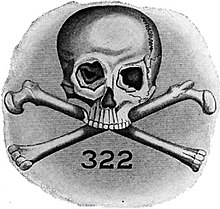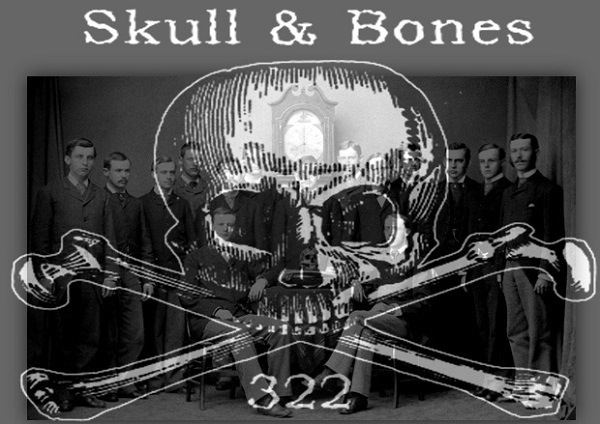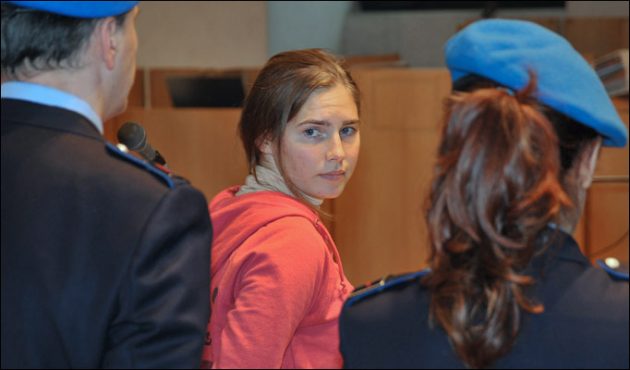
The logo of Skull and Bones
|
|
| Formation | 1832 |
|---|---|
| Type | Secret society |
| Headquarters | Yale University |
| Location |
|
Skull and Bones is an undergraduate senior secret society at Yale University, New Haven, Connecticut. It is the oldest senior class landed society at Yale. The society’s alumni organization, the Russell Trust Association, owns the society’s real estate and oversees the organization. The society is known informally as “Bones”, and members are known as “Bonesmen”.
Contents
- 1 History
- 2 Facilities
- 2.1 Tomb
- 2.2 Deer Island
- 3 Bonesmen
- 4 Lore
- 4.1 Crooking
- 5 Conspiracy theories
- 6 References in fiction
- 7 References
- 8 Further reading
- 9 External links
History
Skull and Bones was founded in 1832 after a dispute between Yale debating societies Linonia, Brothers in Unity, and the Calliopean Society over that season’s Phi Beta Kappaawards. It was co-founded by William Huntington Russell and Alphonso Taft as “the Order of the Scull [sic] and Bones”.
The society’s assets are managed by the society’s alumni organization, the Russell Trust Association, incorporated in 1856 and named after the Bones co-founder. The association was founded by Russell and Daniel Coit Gilman, a Skull and Bones member, and later president of the University of California, first president of Johns Hopkins University, and the founding president of the Carnegie Institution.
The first extended description of Skull and Bones, published in 1871 by Lyman Bagg in his book Four Years at Yale, noted that “the mystery now attending its existence forms the one great enigma which college gossip never tires of discussing.” Brooks Mather Kelley attributed the interest in Yale senior societies to the fact that underclassmen members of then freshman, sophomore, and junior class societies returned to campus the following years and could share information about society rituals, while graduating seniors were, with their knowledge of such, at least a step removed from campus life.
Skull and Bones selects new members among students every spring as part of Yale University’s “Tap Day”, and has done so since 1879. Since the society’s inclusion of women in the early 1990s, Skull and Bones selects fifteen men and women of the junior class to join the society. Skull and Bones “taps” those that it views as campus leaders and other notable figures for its membership.
Facilities
Tomb
The Skull and Bones Hall is otherwise known as the “Tomb”.

The tomb before the addition of a second wing
The building was built in three phases: the first wing was built in 1856, the second wing in 1903, and Davis-designed Neo-Gothic towers were added to the rear garden in 1912. The front and side facades are of Portland brownstone in an Egypto-Doric style. The 1912 tower additions created a small enclosed courtyard in the rear of the building, designed by Evarts Tracy and Edgerton Swartwout of Tracy and Swartwout, New York.[7] Evarts was not a Bonesman, but his paternal grandmother, Martha Sherman Evarts, and maternal grandmother, Mary Evarts, were the sisters of William Maxwell Evarts, an 1837 Bonesman.

A 2009 view of the tomb from across High Street
The architectural attribution of the original hall is in dispute. The architect was possibly Alexander Jackson Davis or Henry Austin. Architectural historian Patrick Pinnell includes an in-depth discussion of the dispute over the identity of the original architect in his 1999 Yale campus history. Pinnell speculates that the re-use of the Davis towers in 1911 suggests Davis’s role in the original building and, conversely, Austin was responsible for the architecturally similar brownstone Egyptian Revival Grove Street Cemetery gates, built in 1845. Pinnell also discusses the “Tomb’s” aesthetic place in relation to its neighbors, including the Yale University Art Gallery. In the late 1990s, New Hampshire landscape architects Saucier and Flynn designed the wrought iron fence that currently surrounds a portion of the complex.
Deer Island
The society owns and manages Deer Island, an island retreat on the St. Lawrence River. Alexandra Robbins, author of a book on Yale secret societies, wrote:
The forty-acre retreat is intended to give Bonesmen an opportunity to “get together and rekindle old friendships.” A century ago the island sported tennis courts and its softball fields were surrounded by rhubarb plants and gooseberry bushes. Catboats waited on the lake. Stewards catered elegant meals. But although each new Skull and Bones member still visits Deer Island, the place leaves something to be desired. “Now it is just a bunch of burned-out stone buildings,” a patriarch sighs. “It’s basically ruins.” Another Bonesman says that to call the island “rustic” would be to glorify it. “It’s a dump, but it’s beautiful.”
— Alexandra Robbins
Bonesmen

Yearbook listing of Skull and Bones membership for 1920. The 1920 delegation included co-founders of Time magazine,Briton Hadden and Henry Luce
.
Skull and Bones’s membership developed a reputation in association with the “Power Elite”. Regarding the qualifications for membership, Lanny Davis wrote in the 1968 Yale yearbook:
If the society had a good year, this is what the “ideal” group will consist of: a football captain; a Chairman of the Yale Daily News; a conspicuous radical; a Whiffenpoof; a swimming captain; a notorious drunk with a 94 average; a film-maker; a political columnist; a religious group leader; a Chairman of the Lit; a foreigner; a ladies’ man with two motorcycles; an ex-service man; a negro, if there are enough to go around; a guy nobody else in the group had heard of, ever …
— Lanny Davis, quoted by Alexandra Robbins
Like other Yale senior societies, Skull and Bones membership was almost exclusively limited to white Protestant males for much of its history. While Yale itself had exclusionary policies directed at particular ethnic and religious groups, the senior societies were even more exclusionary. While some Catholics were able to join such groups, Jews were more often not.3 Some of these excluded groups eventually entered Skull and Bones by means of sports, through the society’s practice of tapping standout athletes. Star football players included the first Jewish (Al Hessberg, class of 1938) and African-American (Levi Jackson, class of 1950, who turned down the invitation for the Berzelius Society) students to be tapped for Skull and Bones.
Yale became coeducational in 1969, yet Skull and Bones remained fully male until 1992. The Bones class of 1971’s attempt to tap women for membership was opposed by Bones alumni, who dubbed them the “bad club” and quashed their attempt. “The issue”, as it came to be called by Bonesmen, was debated for decades. The class of 1991 tapped seven female members for membership in the next year’s class, causing conflict with their own alumni association, the Russell Trust. The Trust changed the locks on the Tomb and the Bonesmen instead met in the Manuscript Society building. A mail-in vote by members decided 368-320 to permit women in the society, but a group of alumni led by William F. Buckley obtained a temporary restraining order to block the move, arguing that a formal change in bylaws was needed. Other alumni, such as John Kerry and R. Inslee Clark, Jr., spoke out in favor of admitting women. The dispute was highlighted on an editorial page of The New York Times. A second alumni vote, in October 1991, agreed to accept the Class of 1992, and the lawsuit was dropped.
Judith Ann Schiff, Chief Research Archivist at the Yale University Library, has written: “The names of its members weren’t kept secret — that was an innovation of the 1970s — but its meetings and practices were.” While resourceful researchers could assemble member data from these original sources, in 1985, an anonymous source leaked rosters to Antony C. Sutton. This membership information was kept privately for over 15 years, as Sutton feared that the photocopied pages could somehow identify the member who leaked it. He wrote a book on the group, America’s Secret Establishment: An Introduction to the Order of Skull and Bones. The information was finally reformatted as an appendix in the book Fleshing out Skull and Bones, a compilation edited by Kris Millegan and published in 2003.
Among prominent alumni are former President and Supreme Court Justice William Howard Taft (a founder’s son); former Presidents George H. W. Bush and his son, George W. Bush; Supreme Court Justices Morrison R. Waite and Potter Stewart;[19] James Jesus Angleton, “mother of the Central Intelligence Agency”; Henry Stimson, U.S. Secretary of War (1940-1945); U.S. Secretary of Defense Robert A. Lovett, who directed the Korean War, William B. Washburn, Governor of Massachusetts; and Henry Luce, founder and publisher of Time, Life, Fortune, and Sports Illustrated magazines.
John Kerry, U.S. Secretary of State and former U.S. Senator; Stephen A. Schwarzman, founder of Blackstone Group; Austan Goolsbee,[20] Chairman of Barack Obama’s Council of Economic Advisers; Harold Stanley, co-founder of Morgan Stanley; and Frederick W. Smith, founder of FedEx, are all reported to be members.
Lore
One legend is that the numbers in the society’s emblem (“322”) represent “founded in ’32, 2nd corps”, referring to a first Corps in an unknown German university. Others suggest that 322 refers to the death of Demosthenes and that documents in the Tomb have purportedly been found dated to “Anno-Demostheni”.
Members are assigned nicknames (e.g., “Long Devil”, the tallest member, and “Boaz”, a varsity football captain, or “Sherrife” prince of future). Many of the chosen names are drawn from literature (e.g., “Hamlet”, “Uncle Remus”), religion, and myth. The banker Lewis Lapham passed on his nickname, “Sancho Panza”, to the political adviser Tex McCrary. Averell Harriman was “Thor”, Henry Luce was “Baal”, McGeorge Bundy was “Odin”, and George H. W. Bush was “Magog”.
In the 2004 U.S. Presidential election, both the Democratic and Republican nominees were alumni. George W. Bush wrote in his autobiography, “[In my] senior year I joined Skull and Bones, a secret society; so secret, I can’t say anything more.” When asked what it meant that he and Bush were both Bonesmen, former Presidential candidate John Kerry said, “Not much, because it’s a secret.”
The society’s current class meets every Thursday and Sunday night during their senior year.
Crooking
Skull and Bones has a reputation for stealing keepsakes from other Yale societies or from campus buildings; society members reportedly call the practice “crooking” and strive to outdo each other’s “crooks”.
The society has been accused of possessing the stolen skulls of Martin Van Buren, Geronimo, and Pancho Villa.
Conspiracy theories
The group Skull and Bones is featured in conspiracy theories, which claim that the society plays a role in a globalist/corporatist conspiracy for world control. Theorists such as Alexandra Robbins suggest that Skull and Bones is a branch of the Illuminati, having been founded by German university alumni following the order’s suppression in their native land by Karl Theodor, Elector of Bavaria with the support of Frederick the Great of Prussia, or that Skull and Bones itself controls the Central Intelligence Agency. Books written about the society include economist Antony C. Sutton’s America’s Secret Establishment: An Introduction to the Order of Skull & Bones and Kris Millegan’s 2003 Fleshing Out Skull and Bones.
Originally posted 2014-03-05 23:16:03. Republished by Blog Post Promoter














